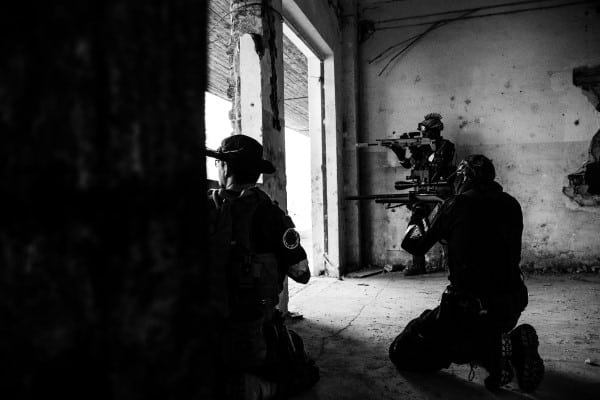Military aid is the supply, donation or loan of money, equipment or training to support a countries armed forces. Donor countries give military aid to help allied nations deter or repel external aggression and achieve internal security. Each year, countries such as the US, UK, France, Russia, and China provide billions of dollars in military aid. However, overseas military aid is highly controversial, and very problematic. Let us explain…
It Can Prolong Conflicts
The first problem with military aid is that is can actually prolong conflicts, not bring them to an end.
When donor nations provide arms, training, materials, and finances to the militaries of other countries, it increases their capacity to fight. This can embolden governments to continue waging conflicts and reduce the chances of them negotiating an end to the fighting.
By providing military aid to foreign governments, donor countries are making their armed forces stronger. The issue with this is it allows them to continue to wage war. In some contexts, this is correct, but in many places, conflicts will only be resolved through dialogue and increasing one sides military strengths decreases their willingness to negotiate.
One of the main aims of military aid is to help allied nations defend themselves and achieve security. However, the problem arises when military aid actually prolongs a conflict, essentially making the country more insecure.
There are many examples of military aid extending conflicts. It could be argued Russian military assistance to the Assad regime in Syria extended the civil war there, or US and NATO support for the Afghan army prolonged that conflict.
It’s Hugely Expensive
The second problem with international military aid is that it is enormously expensive.
Donor countries such as the US, UK, France, and Russia provide billions of dollars a year in military aid to allied countries. This money could be used domestically on important services such as healthcare, education, law enforcement and infrastructure.
Another issue with the huge amounts of money countries spend on military aid is that it is rarely good value. For example, America spent 5.8 trillion dollars in Afghanistan between 2001 and 2021, a large proportion of which went on military assistance to the Afghan army and security services. This money was essentially wasted when in August 2021 the Taliban took control of the country.
Even when military aid achieves its objective the enormous amounts of money spent can be an issue. Arguably Russia has achieved its intended result in Syria by providing military assistance to the Assad regime and preventing its collapse. However, Russia has spent around four million dollars every day it has been in Syria. This is an enormous amount of money, especially for a country where the average monthly wage is only just over 700 USD.
A major problem with overseas military aid is the amounts of money spent that could be directed towards peace building initiatives, humanitarian aid or domestic programmes.
It Can Be Used for Human Rights Abuses
Another problem with overseas military aid is that it can be used to commit crimes, abuses, and human rights violations.
Many donor countries provide military aid to governments that are allied to them or are strategically important. However, many do not seem to do enough to stop the military equipment and training they provide being used by those governments to commit human rights abuses. This is a major issue with foreign military aid.
There are many examples of military aid being provided and then used for human rights violations. In 2019, Israel received 3.8 billion dollars in military aid from the United States. However, the illegal occupation of the West Bank and blockade of Gaza have resulted in reports of human rights abuses. The military support America gives to Israel is either used directly, or allows Israel to divert other resources, to the occupation of Palestinian land.
A further example of military assistance being used for human rights abuses is Afghanistan. America provided billions of dollars to the Afghan government and army. Evidence shows them committing a range of human rights abuses during this period.
It is not just US overseas military aid that can be used for human rights violations. Russian support for the Assad regime in Syria is another example of this significant problem with overseas military assistance.
A Lot Is Lost to Corruption
A major problem with military aid is that a lot of it is lost to corruption. This reduces its effectiveness, increases the cost and limits the overall military ability of the recipient country.
Many of the countries that receive significant amount of military aid are also highly corrupt. Weak central governments often result in instability, as well as corruption. These factors combined pose a major issue for overseas military aid.
There is some evidence that foreign aid actually increases the rate of corruption in a country. Military aid is likely to add to this problem.
An example of the problems with military aid and corruption includes US military assistance to Ukraine. Other examples are Western military aid to Iraq and Afghanistan. In these latter two examples, corruption is seen as one of the major reasons for the failure of these military aid programmes.
Funds, materials, and resources being lost to corruption is a major problem of overseas military aid. Money can be re-directed, equipment and resources syphoned-off and nepotism can reduce the quality of staff throughout a countries armed forces. Issues such as these need to be urgently addressed if military aid is to be effective.
It Can Deter Reform
A problem with foreign military aid is that it can deter reform in the countries it is donated to.
Many governments that are recipients of military aid face wide-ranging issues, including security challenges, corruption, lack of accountability, ineffective operations, and over-bloated bureaucracy. Many of these countries need reform. However, it has been shown that the provision of foreign military aid to many governments reduces their incentive to improve. This is a significant issue with overseas military aid.
Another problem with military aid is that it is often given to governments that are far from democratic. Providing military aid actually allows these governments to stabilise themselves and reduces the chances they will transition towards democracy.
The main aim of military aid is to support allied governments to defend themselves and help strategically important states achieve security. However, it often does this at the expense of these governments becoming more inclusive, effective, and democratic. Many countries find themselves in the ‘conflict trap’ and a big problem with military aid is that it does little to resolve these conflicts.
If the world is to become more secure, stable, and democratic, donor countries must work to address the major issue of military aid deterring recipient countries from reforming.
Military Aid Doesn’t Always Achieve Its Objective
The objective of military aid is to assist allied governments to defend themselves. This can include repelling foreign aggression or combatting armed groups within the country. A major problem with military aid is that it doesn’t always achieve this objective. In fact, some argue overseas military aid rarely achieves its aims.
Billions of dollars a year are provided by donor governments in overseas military aid. If it doesn’t achieve its objective, this poses a major problem. Essentially, if military aid does not ultimately help allied countries to achieve security, then the money is wasted.
There are many examples throughout history of military aid failing to achieve its objective. A major one is US support for South Vietnam. Huge amounts of American resources were dedicated to the South Vietnamese military from 1961 to 1975. In the end, it did not allow the southern government to repel North Vietnamese forces.
Another example of military aid failing is NATO’s support for the Afghan army and security forces. As we discussed above, despite twenty years of support, billions of dollars in aid and significant training and investment, the Afghan army was unable to combat the Taliban effectively.
Military Aid Often Goes to Bad Regimes
The final major problem with overseas military aid is that it is often given to terrible regimes.
Military aid is given by donor countries usually to nations that are strategically important to them. However, many times these regimes are undemocratic and authoritarian. Military aid helps to prop-up these regimes. It also lends them significant international legitimacy.
By providing military aid, donor countries play a major role in ensuring that some of the worst regimes in the world continue. This is one of its biggest problems.
There are many examples of how military aid supports bad regimes. China is currently giving military assistance to Myanmar, allowing the military junta there to continue to suppress pro-democracy protestors.
Another example of how military aid allows some of the worst regimes to continue is Russia’s support for the government of Bashar Al-Assad in Syria. It’s generally agreed this support prevented the fall of that regime.
Western nations also provide military aid to authoritarian regimes, including Saudi Arabia and Egypt.
The supplying of military aid to authoritarian regimes is one of its biggest issues. Donor countries must address this if military aid is to be less controversial.




